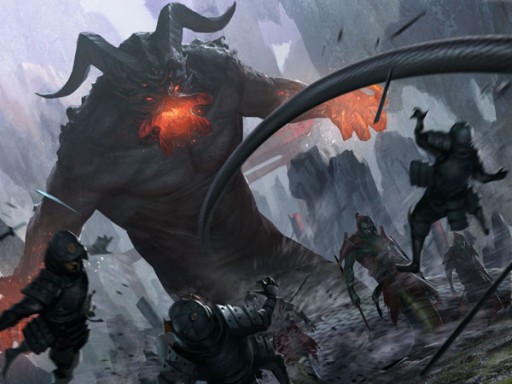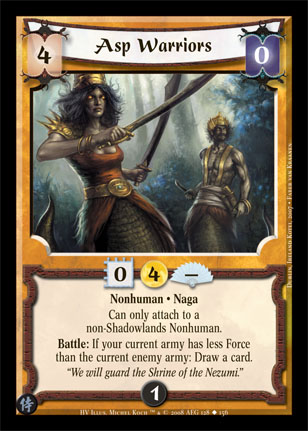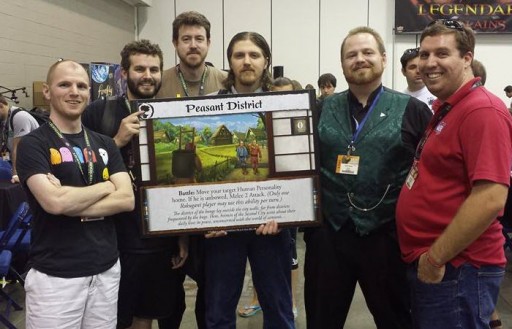Dave of the Five Rings is an ongoing series chronicling David Gordon’s return to the Legend of the Five Rings CCG after several years. He will be tracking his progress from the launch of the game’s new core set, Ivory Edition, through to the season’s culmination at Gen Con 2014.
Chapter 8: The Heart of Darkness
The horror, the horror. Thousands of scaly green bodies, each as powerful as a fully armored and mounted samurai, moving with an inhuman communion towards one single purpose. The forces of the Dark Naga strike the Second City, the capital of the Colonies, without warning, bringing blood and fire in their wake. Standing against them is certain death, but it must be done. They cannot take the Imperial District, not while a single samurai still breathes in the city. All other matters, all other conflicts are cast aside in this single moment of unity for the Rokugani. In this heart of darkness, there is only the difference between human and naga, survival and extinction.
In my previous installment, I discussed my first day at Gen Con along with the storyline prize earned by those who battled the Dark Naga in the 2014 Challenge Booth. The result of which was that the Naga, my original faction, would be returning as a fully playable, supported faction to Legend of the Five Rings in 2016. This was intensely exciting for me, and enough to cinch my continued presence in the CCG despite the flagging numbers in the community and my own poor performance.
However, that poor performance led me to embracing a surprising opportunity that came my way that Thursday. My Spider Deck had proved less than sufficient to make it out of the Thursday qualifiers for the Main Event, and my dreams of participation in the L5R Main Event quickly became a distant dream. Yet what came next was wholly unexpected.
The Challenge
The Heart of Darkness Challenge Booth at 4:00 PM on Thursday was down two players, despite having sold out in pre-registration. Rather than play to a less than full table, Bryan Reese and Dan Dineen opened up the table to people with generic tickets, and the spots filled quickly. I had the good fortune to be one of them. The Challenge Booth had been the aspect of the Gen Con experience that I was most eager for. I was curious how co-op multiplayer would work and how the forces of the Dark Naga would be able to stand against three to five players working together.
To put it simply, I was not disappointed.
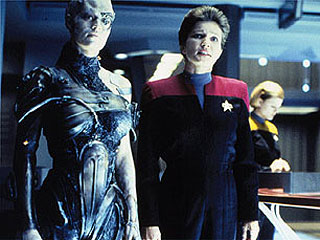
Because sometimes the common enemy is scarier than even the Borg.
One of the fundamental narratives in L5R are the times when the heroes and villains of Rokugan must put aside the conflict between their clans and factions and unite against a greater foe. The founding of the Empire itself in Rokugan stems from the conflict between the Kami who forged the Great Clans and their lost brother, Fu Leng, during the First Day of Thunder. That original great story comes from the battle between Fu Leng and the Seven Thunders at the Second Day of Thunder, played out during the World Championship at Gen Con in 1998.
In recent storylines, the Empire has had to unite against the forces of a gaijin god in the Destroyer War, and before that, against the Lying Darkness’s attempts to unmake all of existence. Time and again, L5R is a game about forces coming together to battle a greater enemy in the name of the Empress or Emperor, or simply for the survival of all, and the new Siege variant was designed to simulate that.
The Siege
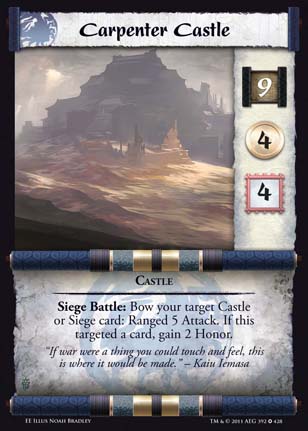 The Siege variant of L5R pits one player against three to five opponents in an asymmetrical multiplayer game. To facilitate this, L5R introduced two new mechanics specifically for Siege. The first was a new Strength icon, which stood in for the number of opponents facing the Siege player. Strength allows the Siege deck to be scalable between the three to five opponents, keeping the forces of the Dark Naga able to handle increasing number of players.
The Siege variant of L5R pits one player against three to five opponents in an asymmetrical multiplayer game. To facilitate this, L5R introduced two new mechanics specifically for Siege. The first was a new Strength icon, which stood in for the number of opponents facing the Siege player. Strength allows the Siege deck to be scalable between the three to five opponents, keeping the forces of the Dark Naga able to handle increasing number of players.
The second was the Unstoppable keyword, giving the Siege player access to actions which could not be countered or negated by their opponents. This ensured that the Siege deck’s player is able to perform the necessary actions to challenge the large number of players facing them, and it often results in extremely powerful swings in combat. Nearly all of the Strategies in the Dark Naga deck have an Unstoppable action on them, and those actions are typically the most worthwhile action to take.
The Rokugani players all take their turns simultaneously, moving through each phase as a group until they all agree to move to the next. Then the Siege player takes a turn. During the Action Phase and the Attack Phase, the opportunity to play an action goes from the Rokugani players to the Siege player and back, as if the Rokugani were a single player. The Action taken by the Rokugani players must be unilaterally agreed upon. Play continues in a Battle or Action Phase until both the Siege player and the Rokugani players consecutively pass.
Winning the Siege
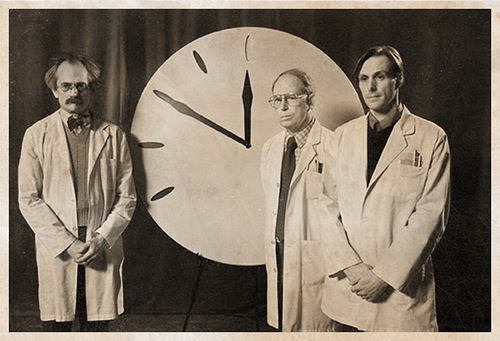
Like this clock, only doomier
Other than those two new mechanics and simultaneous turns, the game plays as a fairly standard game – with a slight variant in the victory conditions. In the Siege variant, the Siege deck is given a Clock Deck, with the last card of the Clock Deck being fixed.
At the start of the Siege player’s turn, the top card of the Clock Deck is revealed and resolved, typically giving the Siege deck an advantage for the turn. The Rokugani players win on the end of the turn the final card of the Clock Deck is revealed.
The Rokugani can replace the active Clock card with the next one in the deck by taking a Province from the Siege player, putting their fifth Elemental Ring into play, or by burning Political counters based on the number of players. Political counters are earned through gaining Honor or inflicting Honor losses on the Siege player. The only card the Rokugani players cannot reveal in this manner is the final card, giving the Siege player one full turn to push for their own victory. The Clock Deck is otherwise untouchable by any other effect, and as the Clock Discard fills, each new Clock card gets more powerful.
In Heart of Darkness, the Siege player is controlling the forces of the Dark Naga. Their Stronghold gives them a prohibitively high Province Strength based on the number of opponents they have, a firm gold scheme, and the trait of creating a number of token Asp Warrior personalities based on the number of players whenever they bring out a Naga Personality. They receive these Warriors for no additional cost. These Asp Warrior tokens serve as the fuel for the Siege deck’s engine, as nearly all the Siege deck’s Actions can be made better by bowing or destroying the Asp Warriors.
Additionally, whenever the Siege player destroys an Asp Warrior, they draw a Fate card, keeping their hand full of applicable combat actions. The Asp Warriors themselves are 2 Force, 2 Chi personalities, allowing the Siege player to very quickly develop enough table Force to simply overcome any opposition they can face.
The Siege player wins by destroying the Imperial District. Five Districts are put into play at the start of the game, giving the Rokugani players various benefits while they remain. These are the areas which the Siege player will be attacking. Each starts as being indestructible, save the Peasant District. This prevents the Dark Naga player from being able to usually take multiple Districts in a single turn. Once the Peasant District is destroyed, the Siege player can destroy the Merchant, Artisan, or Temple District. Destroying any one of these also destroys each Rokugani player’s leftmost Province and opens the Military District up to be destroyed. Should the Military District fall, the Siege player is capable of destroying the Imperial District and winning the game.

Receiving the Quest
As we sat down, all of these rules were explained to us by Bryan Reese, the Lead Designer of Legend of the Five Rings. Bryan was also the designer of the Siege rules variant and by far the most familiar with how the deck should be run. Even then, Bryan was a gracious and friendly organizer. He went out of his way to explain the minutiae of the new rules, and when it was revealed that two of our players had been out of L5R for several years (quite like myself), he provided them with two solid preconstructed decks to play. Representing Rokugan were two Spider decks, two Crane decks, and one Unicorn. I found it amusingly appropriate for the game, as the Spider are traditionally the defenders of the Second City and within the current storyline the Crane were heavily invested in the Colonies.
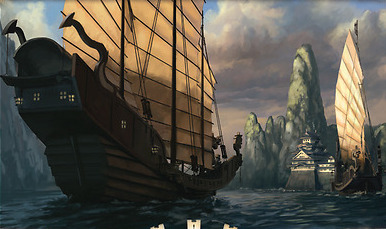 This year’s Challenge Booth was the fight to save the Second City itself – the capital of Rokugan’s Colonies. If the Dark Naga won the Challenge Booth that day, the current District would fall to his serpentine forces. If the Rokugani players won the Challenge Booth, the previously fallen District would be restored. If at the end of the fourth day of Gen Con the Imperial District was still intact, then Rokugan itself would be considered victorious and the Dark Naga would be slain.
This year’s Challenge Booth was the fight to save the Second City itself – the capital of Rokugan’s Colonies. If the Dark Naga won the Challenge Booth that day, the current District would fall to his serpentine forces. If the Rokugani players won the Challenge Booth, the previously fallen District would be restored. If at the end of the fourth day of Gen Con the Imperial District was still intact, then Rokugan itself would be considered victorious and the Dark Naga would be slain.
If the Imperial District fell, then the Second City would be lost entirely.
This tied into the Main Event, as the Saturday Finals would be broken into pods of 8 players. The winner of each pod would select a personality to defend a District in the storyline, and if the District fell, then that personality would be killed battling the Dark Naga. If the District was saved, then the personality would defeat the Dark Naga’s chosen and earn glory for their clan.
We Honor our Fallen Brethren
The players of Team Rokugan were not off to a good start.
The team before us had unfortunately lost to the forces of the Dark Naga, and the Peasant District was in flames. If we did not defeat the Dark Naga, then the Artisan District would be joining the fire. If we succeeded, however, we could push the line in the sand back and save the Peasant District. This early in the convention, we did not feel a great pressure from this burden, as the subsequent Challenge Booths would like trump any outcome we delivered. Still, the sheer ability to square off against the Dark Naga – being played by the man who designed them and under the watchful eye of the present Story Team – meant that none of us were willing to take this game lightly. We shuffled our decks, cracked our knuckles, and got down to brass tacks.

The force of primary colors not withstanding
The first thing that hit me about the Siege deck was how amazingly powerful its actions were. Like any good L5R player, Bryan would use his table actions before moving on to the actions in his hand, and every action felt like it hit with the force of a solid punch. Battles strongly in our favor were swung with single actions from the Siege deck. Key plays centered around knowing what actions we could stop, and accepting which ones we could not. Time and time again, we were caught off guard by the sheer puissance of the Siege deck’s options.
With five opponents, Bryan was also able to keep a large stack of Asp Warriors on hand to keep his Fate hand full. He quickly took the Peasant District and was able to take the Temple District as well. Still, we had our counterstrokes. With four of our five players playing heavily military, and three playing high Honor decks, we were able to burn two cards off the Clock Deck by the time the first attack was launched at the Military District. One was through taking a Province of the Dark Naga’s and the other through Political tokens. Every battle was hard fought, with the Crane military player and the Unicorn player showing amazing skill and strategy bringing us closer to victory with every action they took.
The Battle Continues
The first battle at the Military District proved to be the turning point of the game. Though we lost the battle, we were able to save the District through clever use of the Merchant District’s ability to boost Province Strength for money. When the Dark Naga wins at the Military District, they have to destroy cards in their own army equal to half the number of cards in the Rokugani army. This gave us a final moment of attrition to rally our forces. With four cards left in the Clock Deck, we figured we could survive two more assaults on the Military District. We could not survive four. We quickly secured enough Political tokens to burn one card off the clock, but three fights would still be too dicey. We needed to take another Province.
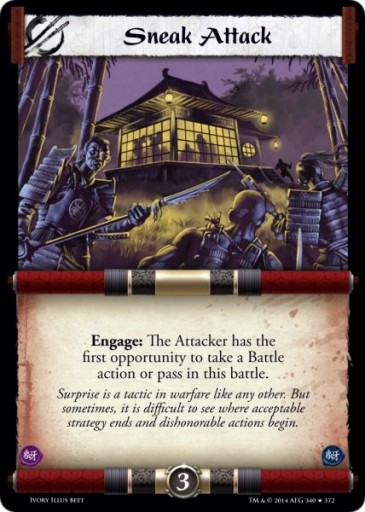 With our standing army, we had enough to Force to take the Province, but even a small amount of Force reduction or send home would possibly change that. Still, with the cards in hand and the forces on the table, we knew we had no other choice. We launched our assault, and Bryan defended with a single Asp Warrior, knowing it would give him the presence necessary to play an Unstoppable action to save the Province and possibly win the game.
With our standing army, we had enough to Force to take the Province, but even a small amount of Force reduction or send home would possibly change that. Still, with the cards in hand and the forces on the table, we knew we had no other choice. We launched our assault, and Bryan defended with a single Asp Warrior, knowing it would give him the presence necessary to play an Unstoppable action to save the Province and possibly win the game.
What he did not see coming was my Sneak Attack card, allowing us to take the first action of the battle. The action used was a massive Fear effect from a unit on the table with Okura’s Released to turn the Fear into a killing action. Sneak Attack was one of the oldest cards in the game, and one whose return to legality slipped mostly unnoticed into the tournament scene. By killing his Warrior, Bryan Reese was denied the ability to play the actions to save the Province, and we were able to burn one more turn off the clock.
The second battle at the Military District saw the forces of the Dark Naga taking an early lead, and our forces were cutting our losses before it hit us that we had a shot at actually winning the fight. Between the Crane players’ actions and the force of the Spider and the Unicorn, we were able to drive back the forces of the Dark Naga and defeat them in battle. With only two Provinces remaining and his army defeated, Reese bowed to our forces and gave us the victory. A cheer went up from the Rokugani as the Peasant District was saved – for now – and we were able to claim the second victory against the Dark Naga that day.
As for the larger fate of the Second City, and my own, that must wait until next time. There, I will finally discuss day two of the Qualifier tournament for the Main Event, as well as my long-awaited turn at playing in Legend of the Five Rings RPG at one of the Heroes of Rokugan events. Until then, let the peasants rejoice.
David Gordon is a regular contributor to the site. A storyteller by trade and avowed tabletop veteran, he also has a long and complicated past with L5R. These are his stories. He can be reached at dave@cardboardrepublic.com.
You can discuss this article and more on our social media!
Photo Credits: Legend of the 5 Rings images by Alderac Entertainment Group; Star Trek Voyager by Paramount Television; Doomsday Clock by Bulletin of Atomic Scientists.

